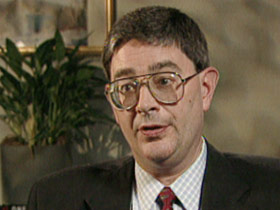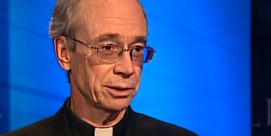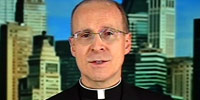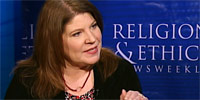In This Episode << SLIDE LEFT TO SEE ADDITIONAL SEGMENTS
George Weigel Extended Interview
Read Bob Abernethy’s interview with George Weigel:
Q: What is the essence of being Catholic?

A: I would say the essence of Catholicism is Jesus Christ — the sure conviction that in Jesus of Nazareth God entered human history in the person of His son, for the salvation of the world, [and] the further conviction that that saving mission continues in the Church, which is an extension of Christ — which is, indeed, the body of Christ. To meet Jesus Christ is to meet His Church and become incorporated into that Church, and to live that Christian life through the Church — through its sacraments, through its moral teaching, through its community of fellowship, through its service to the world. But at the heart of it all is the person of Christ. Christ is the essence of all Christianity. Christ is the essence of Catholicism.
Q: How does Protestantism differ from Catholicism?
A: Catholicism understands itself to be the fullest embodiment of the Church of Christ in history. Namely, Christ intended not only a fellowship, a community of disciples, but a structure for that community. Key parts of that structure are the episcopate, the office of bishop as the pastoral leadership of the Church. The chief bishop, the bishop of Rome, the successor of Peter, is a crucial part of that structure. And a sacramental priesthood in which the priest is understood not as an ecclesiastical functionary who’s licensed to do certain kinds of church business; a priest understood as an icon of the eternal priesthood of Christ, whose priesthood continues in the Church. Those notions — and particularly the centrality of the Petrine ministry as the continuation of Christ’s mandate to Peter, embodied now in a living, in the bishop of Rome and, thus, a connection to the apostolic origins of the Church — are very much at the heart of Catholic Christianity.
Q: And what about the sacraments?
A: One of the distinctive things about Catholicism is its intensely sacramental understanding of the world. In a Catholic vision of reality, everything discloses something else. Water and salt in baptism disclose the salvation of God working — at work in an individual life. Bread and wine in the Eucharist become the body and blood of Christ. Marital love within the bond of fidelity discloses the truth of God’s self-giving love to the world. Stuff counts in Catholicism, and that sacramental imagination about all of reality is intensely expressed in what Catholics call the seven sacraments of the Church.
Q: Let me move on to the current crisis in the Church. In your judgment, why has it become so acute? Why are so many Catholics — and others — so angry?
A: This is fundamentally a crisis of fidelity. If a man truly believes that he is what the Catholic Church teaches he is as a priest — namely, an icon, a living representation of the eternal priesthood of Jesus Christ — he does not behave as a sexual predator. So, at the bottom of the bottom line here, we have a crisis of fidelity. We have a crisis of failed discipleship. The normal reaction to that among people is a deep sense of betrayal, a deep sense of hurt, and anger that the pastoral authorities in the Church have not sufficiently dealt with this in the past. It’s important to remember two things here. One is that the overwhelming majority of Catholic priests in the United States are leading faithful lives of heroic virtue. The second is that betrayal has been part of the story of the Church from the beginning. It’s interesting that in constructing the New Testament, the Church did not eliminate the story of Judas. Judas is in the New Testament, but Judas is not the story line. The story line as it plays out in the Gospels and in the Acts of the Apostles is fidelity. And that is what I believe, at the end of the day, will come out of this current crisis — a renewal of fidelity to integral Catholic faith.
Q: Is the problem a problem of homosexuality?
A: Sexual abuse, as we have come to see over the past four months, manifests itself in three ways. There is pedophilia, strictly speaking — the sexual predation on children, the most revolting form of this and, seemingly, the least prevalent form of this. Then there is the age-old problem of clerical misconduct with women. What seems to be the bulk of the problem — at least in the period between the late ’60s and the late 1980s — has been the sexual abuse of young men and teenage boys by clergy, and I think the normal English definition of that is homosexual abuse.
Q: And to what extent do you see in the criticism an effort by people with their own agendas to try to, in their view, reform the Church, to make big changes in its rules?
A: It seems clear to me that there has been a fair amount of ideological joyriding on this crisis — a graying, aging, unreproductive generation of dissent seeing in this crisis an opportunity to advance items on its agenda which have gotten no traction in the previous 25 years. It is also true that the secular enemies of the Catholic Church have seen this as a great opportunity to take the Church down a notch or four. But all of that having been said, it also has to be said that this is our problem. This is the Church’s problem. This is a problem of all, for all the people in the Church. It would be the grossest of irresponsibility, it seems to me, to blame the present sense of a great turmoil on either the press or on dissent within the Church. This is a real problem, and it needs real solutions. The real solution is for the Church to become more Catholic, not less Catholic.
Q: What do you mean by that?
A: I mean people living integrally Catholic lives. I mean the recognition that “cafeteria” Catholicism is simply unserious. The Catholic faith is not a smorgasbord down which you can walk, saying, “That looks good,” “That doesn’t look so good.” It’s a complete package. And when we try to convince ourselves that it is a smorgasbord, a cafeteria, a certain corruption comes into the whole enterprise. That’s what we’re seeing played out.
Q: What do you mean by the “smorgasbord”?
A: I mean, with particular reference to the moral teaching of the Church, dissent on what are settled matters of Catholic moral doctrine, with specific reference to the Church’s sexual ethic. A generation of seminarians, from the mid-’60s to, perhaps, the mid-’80s, grew up in seminaries where it was tacitly understood that you could dissent from the Church’s sexual ethic as long as you didn’t publicize that. That led to an intellectual self-deception that I think eventually led to behavioral self-deception — people giving themselves passes on behavior as they once gave themselves passes on conviction.
Q: Talk about the hierarchy in this country. It seems to many people that there was a fundamental failure to acknowledge what was going on, to deal with it, to bring it out in the open. People are, perhaps, more angry about that, about the cover-up, than they are about the original incidents of abuse. I’m wondering to what extent you agree with that.
A: I think there has been serious, serious mismanagement, serious failures of leadership in coming to grips with all of these problems of abuse for the past 20 years. Some of that failure is the result of misplaced compassion — not wanting to throw priests overboard, wanting to give them the chance to reform their lives. Some of it, frankly, is buying into a therapeutic culture that treated these wicked acts as primarily forms of mental illness, rather than as the gross sins that they also are. On the question of cover-up: that’s a term we got used to during Watergate and other political messes in our country. We should understand that in many instances it was victims’ families who preferred out-of-court settlements in order not to subject the victim to the second victimization of a public trial. On the other hand, it also has to be said that bishops have been extremely negligent in reassigning priests without adequate warning to the place where they were being reassigned that there might be potential trouble.
Q: What’s your assessment, then, of the damage done so far to the Church? How extensive is it? How severe? How costly?
A: I think this is actually a great opportunity. “Crisis” in the language of the Bible means a mess — our conventional meaning of the term. It also means an opportunity. This is an opportunity to really complete the reform of the priesthood, of the episcopate — and, indeed, of all of Catholic life — mandated by the Second Vatican Council. I am deeply impressed that Catholics are not abandoning their priests; that, in fact, they are rallying to the support of the good priests they know. I think their justifiable dissatisfaction, even anger, with the failures of leadership by bishops will result in stronger leadership in the future. As grim as this looks at the moment, I believe that in time it will result in a renewed, reformed, reinvigorated Catholicism in America.
Q: When you say “renewed” and “reformed” and “reinvigorated,” what do you have in mind?
A: I have in mind a Catholic Church in which 60 million people live the fullness of Catholic faith, live the truth of Catholic faith, participate vigorously in the liturgical life of the Church, are actively in service to society, are bringing the wisdom of Catholic social doctrine to our public life. That’s what I mean by a renewed and reinvigorated Church.
Q: What is required, then, for the Church to restore confidence, restore trust, restore faithfulness, and overcome the problem?
A: The prime requisite right now is leadership from the bishops of the United States. This is primarily their problem to fix. They need a lot of help in fixing it, and I think they’ve recognized that. The first thing I think they need to do in June is to express their profound repentance and sorrow over this. Some have said — I think accurately — that the first thing the bishops should be in Dallas is on their knees, before God, before the Church, before each other. Then it’s clear that we need structural reform in the way clergy personnel policies are handled. And there, I think lay people can be of great help. But beyond all that, we need a deep recommitment to the fullness of Catholic faith. This is a crisis of fidelity, and the only answer to a crisis of fidelity is an intensified faithfulness to the truth that the Church carries in the world.
Q: What has been the impact of this, do you think, on John Paul II?
A: I think it’s been agony for him. This is a man who for 23 years has challenged the priests of the entire world to live a heroic and noble vision of their priesthood, as he has lived a heroic and noble ideal of his priesthood since 1946. No one who knows this man cannot but believe that he is suffering intensely because of this. I think he has also given very clear instructions to the bishops of the United States that this is to be fixed quickly, and that it is to be fixed not simply by administrative procedures but by a genuine reform of the entire life of the Church along the lines of integral faithfulness.
Q: To what extent do you think the scandal has affected the reputation and the legacy of this pope?
A: It will certainly be part of any assessment of this pontificate. It can’t help but be a part of that. But it is not fair, nor accurate, to say that the pope has only been paying attention recently. The pope has been writing about the reform of the priesthood for 23 years. The pope wrote 23 letters to priests on Holy Thursday, before our American press paid attention to one of them this past Easter season. The pope called the senate of bishops from all over the world in 1987, to reform seminaries. And that has had a good effect. So the judgment will have to be a complex and nuanced one, but that this is part of the package of this pontificate, no one can doubt.
Q: To what extent has this hurt the Church, and to what extent will it will change the Church?
A: It has clearly hurt the people of the Church. It has hurt the image of the Church. It is not going to be easy for the Church to promote and defend its sexual ethic in the future; but, then, it’s never been easy for it to do that. I think when people take a deep breath, perhaps later this summer, what they’re going to recognize is here is a great institution wrestling publicly with its reform. Not many institutions can do that. The White House didn’t do it for three years during a recent presidency. Corporations don’t have this kind of public airing of dirty laundry and clear efforts to clean up the mess and get on with things. I think people will recognize that, for all of the mistakes that have been made — and they have been many and grievous — at the bottom of the bottom line, what we’re seeing is a great institution renewing itself from within by becoming more true to itself.
Q: Some critics would say that what you mean by “reform” is very different from what they mean by “reform,” and the direction that you want it to go is, in their judgment, a wrong way.
A: Well, I think they’re mistaken. It seems to me pluperfectly, blindingly obvious that this crisis is a crisis of fidelity. It’s not priests who have been living the fullness of Catholic faith who have been committing these awful sins and crimes. These problems have been shaped by a culture of dissent in which people got the impression that they could pick and choose among teachings and, indeed, among behaviors and remain seriously Catholic. The way out of this is not Catholic lite. It’s real Catholicism, full Catholicism. And I think that’s exactly what’s going to come out of this — is a reinvigoration of classic Catholic faith.







